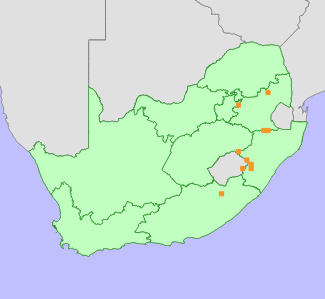|
Scientific Name | Disperis concinna Schltr. |
Higher Classification | Monocotyledons |
Family | ORCHIDACEAE |
Common Names | Neat Granny Bonnet (e) |
National Status |
Status and Criteria | Least Concern |
Assessment Date | 2020/02/18 |
Assessor(s) | L. von Staden, J.E. Victor, D. McMurtry, L. Grobler & S. Burns |
Justification | Disperis concinna is a widespread, but very rare species. It is likely to be declining due to ongoing habitat loss and degradation, but available data on this species does not meet any of the criteria indicating a high risk of extinction. |
Distribution |
Endemism | Not endemic to South Africa |
Provincial distribution | Eastern Cape, Gauteng, KwaZulu-Natal, Mpumalanga |
Range | The type specimen was collected from near Bronkhorstspruit, on the border between Mpumalanga and Gauteng, but it has not been recorded in the area since then. The species is known from a few scattered records from the Mpumalanga Drakensberg escarpment, around Wakkerstroom and the KwaZulu-Natal and Eastern Cape Drakensberg. It also occurs in Zimbabwe. |
Habitat and Ecology |
Major system | Terrestrial |
Major habitats | Wakkerstroom Montane Grassland, Southern Drakensberg Highland Grassland, Lesotho Highland Basalt Grassland, Northern Drakensberg Highland Grassland, Drakensberg Afroalpine Heathland, Mooi River Highland Grassland, Long Tom Pass Montane Grassland, Eastern Highveld Grassland, Rand Highveld Grassland, uKhahlamba Basalt Grassland |
Description | It occurs in damp grassland, along watercourses or in seepages or rock flushes. |
Threats |
| It has possibly declined due to habitat loss to urban expansion and agriculture in Gauteng. It is threatened by ongoing habitat loss and degradation across most of its range. |
Population |
This is a widespread, but extremely rare species, known from only a few scattered records.
|
Population trend | Unknown |
Assessment History |
Taxon assessed |
Status and Criteria |
Citation/Red List version | | Disperis concinna Schltr. | Least Concern | Raimondo et al. (2009) | | Disperis concinna Schltr. | Least Concern | Pfab and Victor (2002) | | Disperis concinna Schltr. | Lower Risk - Least Concern | Victor (2002) | | Disperis concinna Schltr. | Lower Risk - Least Concern | Scott-Shaw (1999) | | Disperis concinna Schltr. | Rare | Hilton-Taylor (1996) | | Disperis concinna Schltr. | Uncertain | Hall et al. (1980) | |
Bibliography |
Hall, A.V., De Winter, M., De Winter, B. and Van Oosterhout, S.A.M. 1980. Threatened plants of southern Africa. South African National Scienctific Programmes Report 45. CSIR, Pretoria.
Hilton-Taylor, C. 1996. Red data list of southern African plants. Strelitzia 4. South African National Botanical Institute, Pretoria.
Johnson, S. and Bytebier, B. 2015. Orchids of South Africa: A field guide. Struik Nature, Cape Town.
Linder, H.P. and Kurzweil, H. 1999. Orchids of southern Africa. A.A. Balkema, Rotterdam.
Pfab, M.F. and Victor, J.E. 2002. Threatened plants of Gauteng, South Africa. South African Journal of Botany 68:370-375.
Pooley, E. 2003. Mountain flowers: a field guide to the flora of the Drakensberg and Lesotho. Natal Flora Publications Trust, Durban.
Raimondo, D., von Staden, L., Foden, W., Victor, J.E., Helme, N.A., Turner, R.C., Kamundi, D.A. and Manyama, P.A. 2009. Red List of South African Plants. Strelitzia 25. South African National Biodiversity Institute, Pretoria.
Scott-Shaw, C.R. 1999. Rare and threatened plants of KwaZulu-Natal and neighbouring regions. KwaZulu-Natal Nature Conservation Service, Pietermaritzburg.
Victor, J.E. 2002. South Africa. In: J.S. Golding (ed), Southern African plant Red Data Lists. Southern African Botanical Diversity Network Report 14 (pp. 93-120), SABONET, Pretoria.
|
Citation |
| von Staden, L., Victor, J.E., McMurtry, D., Grobler, L. & Burns, S. 2020. Disperis concinna Schltr. National Assessment: Red List of South African Plants version . Accessed on 2025/09/17 |
 Comment on this assessment
Comment on this assessment

